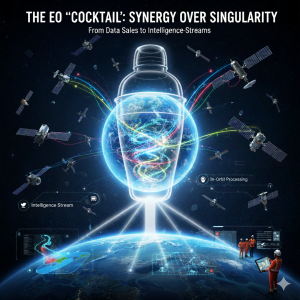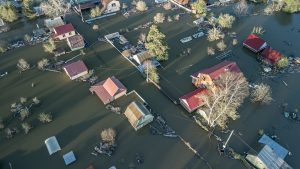A “cocktail” approach to Earth observation has the potential to integrate diverse data from multiple providers to quickly and affordably provide actionable intelligence for effective decision-making across a variety of sectors.
The Earth Observation (EO) sector’s basic model of selling high-cost, single-source imagery is no longer sustainable. The traditional EO market, built on the premise of selling raw pixels as a commodity, may be disappearing. We are now in a golden age of satellite data, with more satellite constellations than ever before, both public and commercial.
However, the data market is still stuck in the analogue era, where the sale of expensive, siled raw images is prioritized, and the narrative is driven by the big players in the market who sell to high spenders. This outdated model undermines the potential of space-based intelligence and hinders everything from infrastructure planning to, most importantly, information intelligence and disaster response, where the story could actually be better.
The current challenge is not a lack of data. It’s the lack of intelligent and affordable access. We need fundamental market disruption. It’s a shift from selling expensive, single-source raw imagery to delivering an agile, multi-provider “cocktail” of data, an actionable intelligence stream that can be quickly deployed both in orbit and on the ground. The sustainability of the entire EO ecosystem, and the safety of the planet’s inhabitants, depends on embracing this collaborative future.

The single image trap
For decades, the standard business model in commercial EO has been simple. The idea was to launch high-resolution satellites, take photographs, and sell the images at a high price. This model made sense when satellites were scarce, expensive government assets, or the vanguard of private enterprise. But today it has become an obstacle.
This paradigm requires customers, from private cooperatives and national mapping agencies to humanitarian organizations, to become experts in data management. Companies must navigate a fragmented environment of dozens of vendors, each offering unique sensor types (high-resolution optical, synthetic aperture radar (SAR), hyperspectral, etc.) with different licensing terms and exorbitant prices.
As a result, a system with the following characteristics was born.
High cost and low access: The high cost of purchasing multiple overlapping high-resolution images prevents sustainable large-scale adoption. Only the wealthiest organizations are able to provide consistent insurance, leaving the public sector, NGOs, and much of the developing world left behind. Data silos: Each vendor’s product is treated as a separate, standalone product. This forces analysts to manually combine incompatible datasets, slowing analysis and often yielding inferior results compared to harmonized streams. Latency period during a crisis: In disaster scenarios such as sudden floods, landslides, and wildfires, every second counts. Waiting for a single private provider’s operations and ground stations to coordinate, placing expensive rush orders, and receiving and processing raw data wastes critical time. Traditional models are fundamentally at odds with the urgency of rapid intelligence gathering, emergency response, and humanitarian assistance.
EO “cocktail”: Synergy beyond singularity
The future of Earth observation is not about the dominance of a single great sensor. It’s a synergistic blend of many things. This is the EO cocktail approach.
Imagine a user needs to assess flood damage. You don’t just need one image. They quickly need critical intelligence, comprised of different images and data types, that is easily understood by humans and LLMs, for quick and actionable decision-making. In this specific example of flood damage, such a data cocktail should consist of: Images seen through clouds and images capturing water coverage at night, if desired. For context, land cover classification, and pre-event baselines. Ultra-high resolution images and IoT sensors for accurate damage assessment of critical infrastructure (bridges, power plants). Topographic data is essential for hydrographic modeling and predicting water movement.
No single provider can adequately provide all this data. Nor can a single sensor simultaneously provide the required fidelity and frequency. The cocktail model proposes an intelligence layer that automatically blends inputs from both the public domain (such as free open data from Copernicus/Sentinel and Landsat) and the commercial sector.

The value proposition completely changes. Customers no longer have to pay high prices for raw VHR images. They pay an affordable subscription-based fee for a consistently updated “Flood Intelligence Stream,” also known as “FloodPin,” a processed and harmonized ready-to-use product. This maximizes the return on investment from public satellites and ensures a clear and sustainable business model for commercial operators specializing in providing complementary, high-value data components.
From data sales to intelligence streams
This revolution requires a complete restructuring of the supply chain, transforming the market from a commodity business (selling pixels) to an essential utility (selling insights).
The importance of latency: On-orbit processing
One of the most fundamental changes is the move to onboard processing. For time-critical applications like disaster monitoring, getting petabytes of raw data to Earth, processing it at ground stations, and getting the resulting intelligence back to the field causes delays.
Next-generation satellites, satellite constellations, or entire in-orbit cloud computing infrastructures will incorporate powerful processing capabilities, often powered by AI and machine learning (AI/ML) chips, that can perform critical analytical tasks in orbit. For example, satellites can identify newly formed flood boundaries in remote areas, compress that single piece of information, and downlink small data packages directly to nearby tactical ground stations, or mobile devices.
This approach significantly reduces dependence on ground infrastructure, reduces latency from hours to minutes, and minimizes bandwidth requirements. This is a key element in providing reliable, high-fidelity intelligence in crisis-affected areas.
The power of service models
On the ground, the new ecosystem will thrive on Data-as-a-Service (DaaS), or more appropriately, Intelligence-as-a-Service (IaaS). The companies that excel in this new era will be mixologists, platforms that can capture, clean, harmonize, and analyze data cocktails, selling answers rather than raw materials.
This is exactly the kind of innovation that companies like RSS-Hydro are pioneering with tools like FloodPin. These systems leverage rapid multi-sensor approaches to achieve near real-time flood monitoring and disaster assessment. They are not selling snapshots of Sentinel images or commercial images. They sell accurate, time-stamped impact intelligence – intelligence that saves lives. By focusing on solutions, we show how to achieve speed, accuracy, and ultimately affordability.
Must-haves: Affordability and sustainable adoption
This need for market disruption is not simply a matter of technological advancement. It is an economic and ethical imperative.
sustainable intake
The current high cost model is the biggest barrier to sustainable adoption by the public and private sectors. Governments require consistent, multi-year, continent-wide monitoring for climate adaptation, infrastructure planning, and complete ecosystem management. You can’t budget to buy a single image at a high price on an ad-hoc basis. Affordable and reliable IaaS subscriptions provide a guaranteed, harmonized intelligence stream, enabling consistent budget planning and widespread integration of EO data into daily operations. This stable revenue stream allows commercial providers to invest in innovation with confidence.
Democratizing disaster response
In the context of humanitarian response, the inability of markets to provide affordable and rapid information is itself a crisis. When a Category 5 hurricane strikes a low-income country, or indeed a high-income country, the inability of local governments and aid organizations to quickly access and provide the most accurate information directly results in more loss of life and greater economic damage.
By moving to a “cocktail” model, the international community will ensure that essential life-saving intelligence becomes an affordable utility. This will ensure that the best possible images of the ground, brought together by NASA, ESA, JAXA, and dozens of private companies, are immediately deployed to the most vulnerable communities, rather than being monopolized by the highest bidder.
The days of fairly expensive, newly acquired single satellite images must end. The future of Earth observation will be built on a foundation of multi-source intelligence streams that are collaborative, automated, and affordable. Only then can we fulfill the promise of space technology: to serve as essential and reliable eyes on our planet, working tirelessly to protect and sustain life on Earth.
This article will also be published in the quarterly magazine issue 24.
Source link

